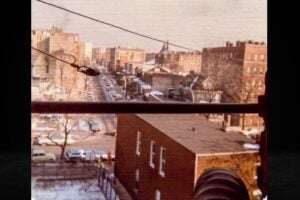
Photo: American Publicity Co., Syracuse, NY [Public domain]
The state fair features exhibits and competitions from the entire state. Agriculture, entertainment, concerts, education, rides, technology and a variety of food choices comprise New York’s largest annual festival. Displays involve 4-H and other organizations, plenty of rabbits, cavies and ducks, and sheep, pigs, horses and goats. Hundreds of thousands of families attend the fair each year.
The New York fair is held at the 375-acre Empire Expo Center on the shores of Onondaga Lake in the town of Geddes, which is on the western border of Syracuse. It is within a four-hour drive from New York City. The drive from Albany is between two and three hours. More than 100 buildings on the property showcase ribbon-winning animals, demonstrations and permanent exhibits that include model train layouts and a tribute to the various circuses that traveled through the state. The New York State Department of Agriculture and Markets owns and operates five of the buildings.

Photo: Postcard 1915 New York State Fair -Public Domain
A Fair-ly Long History
The Great New York State Fair is the oldest and one of the largest state fairs in the country, currently drawing nearly one million visitors annually. It all began during February 1832, when the New York State Agricultural Society was founded in Albany by farmers, legislators and other citizens interested in promoting agricultural improvement and local fairs.
The first state-wide fair in New York, with speeches, animal exhibits, a plowing contest, and manufactured and home goods, was held in Syracuse on September 29-30, 1841. The fair moved to Albany the following year. Through 1889, the fair traveled to a number of other cities—Auburn, Buffalo, Elmira, New York City, Poughkeepsie, Rochester, Saratoga Springs, Utica and Watertown.
Syracuse became the fair’s permanent home during 1890. The Syracuse Land Company donated 100 acres in Geddes to the state Agricultural Society. The location was populated by railways that allowed for economical and quick movement of exhibits, animals and people. Permanent buildings were added to the property, but this development pushed the Agricultural Society into debt. The state government purchased the grounds during 1899 and assumed management of the fair the following year.
Under the state’s administration, construction was completed for the Manufacturers and Liberal Arts Building (now the Center of Progress Building), the Dairy Products Building and the Grange Building (now the Science & Industry Building). Continued progress, however, was interrupted during World War I and World War II.
The grounds, designated Camp Syracuse, were used for military training of approximately 40,000 soldiers during the first war. After the war, additional buildings were added to the property and, during 1938, the fair was renamed the New York State Agricultural and Industrial Exposition. The schedule was extended to 14 days and entertainment acts were added to the festivities.
The fair was cancelled during the World War II years and the grounds again were adapted for military training. A small fair was held during 1948 and a six-day event drawing large crowds was featured the following year. By the end of the 1950s, the fair schedule had expanded to nine days and annual attendance soared to more than 500,000.
From 1962 through 1966, the fair was rebranded as the New York State Exposition. The following year, it was renamed the New York State Fair. Festivities were expanded to 10 days during 1978 and to 12 days during 1990.
A Fair Transformation
A $50 million transformation of the fairgrounds was announced on January 21, 2015. The state’s investment included rebuilding the main gate to replicate the 1840 carriage entrance, a new midway, the addition of an RV park and preservation of the five oldest buildings. Additional renovations are anticipated in phase two of the project.
The culinary offerings at the Great New York State Fair is the one disappointing take-away from the two-week celebration. While the variety of food choices is considerable and the quality of the prepared dishes rates high, the fair has not featured the new and unique cuisine popular at fair’s throughout North America as spotlighted on the Carnival Eats television program.
All Year Long
The New York State Fairgrounds operate beyond the two weeks of summer fun. The property hosts hundreds of events, such as 40 equine events, that draw an estimated one million people. An outdoor American Hockey League game attracted more than 20,000 fans a handful of years ago. The Syracuse Nationals, one of the top five classic car shows in the country, annually draws 80,000 people to a weekend event.
Permanent exhibits such as antique tractors and the carriage museum are featured in several of the buildings on the property. These exhibits, however, may not be open during every month of the year.
Learn more about New York’s annual showcase at NYS Fair (https://nysfair.ny.gov/) . Better yet, plan a trip to Syracuse this year to enjoy The Great New York State Fair.
All photos below Mike Virgintino ©2019

Visitor Map of the Great New York State Fair grounds and exhibits.

This circa 1951 model recalls the annual visit of the Ringling Brothers and Barnum & Bailey Circus at New York City’s old Madison Square Garden on Eighth Avenue between 49th Street and 50th Street in Manhattan.

Tributes to the circuses that traveled through New York State can be seen in an exhibit that features memorabilia and scale models.

One of many model train layouts exhibited at the Great New York State Fair.
Mike Virgintino is the author of Freedomland U.S.A.: The Definitive History, the story about America’s theme park published by Theme Park Press. It can be found on Amazon, eBay, Goodreads and Barnes & Noble.
Click on pic for link to book on Amazon.
































Dutchess County Fair is better.